A lengthy process of research began. I read everything I
could get my hands on. I began talking to nuts, want-a-bes, former owners of Eagles,
professional converters, even bus line owners. Since I was planning on removing the
windows and updating the look to a model 15, I came to the conclusion that it would be a
foolish mistake not to raise the roof. I employed the Ben Franklin method of decision
making. On one side of the scale I put the +’s and on the other side I put the
–‘s. The side weighting the most wins.
| (+) PROS |
(-) CONS |
| More headroom |
Limited headroom |
| Better looks |
Less space to work with |
| More space |
Fewer options |
| Additional options including: |
Less initial work |
|
Overhead ducking |
Could save time & start |
|
Recessed lighting |
Conversion sooner |
|
Recessed mirrors |
|
|
Room for fans, |
|
|
Greater variety in ceiling cover, |
|
|
Increase in value, |
|
|
Personal preference/challenge |
|
Based on this method, my decision was made.
I was going to raise the roof. Now I needed to know how. This question brought me back to
talking to people who had done it to find the best method possible. You see I tend to be
lazy and don’t want to reinvent the wheel. Unfortunately, everyone had his own way of
doing it. All were similar and all achieved the goal of raising the roof. Some methods
seemed more structurally sound than others I thought. My goal was to raise the roof, and
when completed, it would be at least as sound structurally as before any cutting took
place—hopefully stronger. This we succeeded in doing.
At this point with the decision made to raise the roof, it
was time to order and purchase the new fiberglass caps so they would be ready when I
needed them. Now the work begins.
Gut the monster:
This is the wonderful process of cleaning
‘everything’ out of the coach. My definition of everything is to remove anything
that is between you and the framework and outside skin. I loosened the floor but did not
remove it at this point. It is much safer to walk on the old floor instead of the floor
framework.
Should you be able to find someone who will gut it for you
then I strongly suggest you pay him or her. It will turn out to be an experience where if
one is not careful he will loose his religion. I suggest that you save the aluminum sheets
that make up the interior roof. These will prove to be of value later in the conversion.
Any other scrap aluminum can be sold to a recycler.
A good primer:
At this point I chose to use a wire brush on a 4 ½"
side grinder and cleaned the framework and remove the old insulation that did not come off
easily. I then proceeded to paint the framework with a good quality red primer.
How high?
This was the next question to face. In some parts of the
country one does not need to be concerned about the height of a vehicle. However, in the
East it does become a major concern particularly on roads other than interstates. The top
of a coach can get cleaned real good, real fast. On more than one occasion I have TV
antennas, AC’s, luggage covers and other items at low underpasses. If you plan on
traveling out west or on the super slab in the east, then don’t go over 13 feet, 6
inches high from the ground to the highest point on the roof. I decide that I would raise
the roof 6 ¼ inches. Now that the height was determined, I was ready to start.
I then leveled the bus and blocked it up; it would not be
moved again until it was re-skinned. Then I removed all the windows. I did not figure on
selling the windows (maybe you can). I knew I would need some of the glass (probably more
than one piece) for the one-piece door I was to make later (from the looks of things now
there may will an article on this procedure as well). Remove the drip rail from the roof
edge and over the door and drivers window. Set these aside – they will be needed
later. With all the windows out, I removed the old front cap and the rear cap.
Repair and Replace:
This is an excellent point to check he condition of your
framework and replace the rusted pieces as needed. I was fortunate I had only 3 pieces to
replace. Since the tubing is 1 ½" square and can be purchased from your local metal
supplier or welding shop, this becomes no major task. I removed and replaced only what was
necessary.
If you are fortunate enough to have a building to convert
you bus; you won’t need the following info. I had no facility so I went to Harbor
Freight (See endnote #1) and ordered an all weather tarp. I suggest 26 feet by 55 feet
(cost about $50). This size will totally cover your 40-foot bus. Tie all sides down for
protection. With a tarp this size, you can work on a side or end even in the rain because
it can make a shelter to work under.
Next you will need some type of scaffolding. You have
choices:
- Rent from a tool rental
- Borrow from a friend
- Purchase your own
- Build your own
I elected to build my own for several reasons. I
didn’t know how long I would need it, didn’t want to spend the money to buy, and
friends who had it used it in their work. If I built my own, I would save money and when I
was finished, I could dispose of it easily. I decided I needed an adjustable scaffold for
the front and rear (for removing and installing caps) and one to run the length of the
bus. That way I could work one whole side without moving the scaffolding more than 1 time.
I went to a building supply house and purchased 12 pieces
of 2" x 12" x 14’; 20 pieces of 1" x 4" x 16’; and 28 pieces
of 2" x 4" x 24". I started looking for homebuilders and companies that
were discarding pallets. Yes, I made my adjustable scaffolding from used pallets. Most
pallets are made of oak or other hard woods. I needed pallet that were alike and I
assembled them as follows:
Using 2 pallets that are alike, fasten 2x4 to each side as
a scab thereby locking and making the 2 one. With this done, use the 1x4 as diagonal brace
to lock the scaffolding into an upright position. If the horizontal slats are too close,
it will not take away from the strength of the upright to remove every other one. At the
desired height, you need to place 2, 2" x 12" x 14’ between the pallet.
Using two, you have a 2-foot wide working surface. Place one on top of the scaffolding on
the opposite side from where you are working and you have a storage shelf for tools and
supplies.
Level the scaffolding with brick or blocks. With it
relatively level, it can set beside the bus and not rub the skin of the coach. If you
think it will rub, then attach a piece of carpet at spots along the surface next to the
bus to protect the bus. Continue constructing the scaffolding by adding the next upright
and fastening it to the present one until you have scaffolding along the entire side.
Front Cap:
With all the windows out, I removed the old caps starting
with the front one.
With scaffolding in place in the front, rear and along one
side, I drilled the rivets (both rows over the top) using a 3/16" drill. Note: I was
advised to buy a lot of inexpensive 3/16" bits because I would go through them. Tried
that, then decided to buy the titanium nitrate coated drills. They last 6 times longer
than the cheap bit and can be easily reshaped—cheaper by far.
Along the front of the cap just above the windshield, door
and driver’s side window, I found I needed to grind a little off the surface in order
to find the rivets. With all the rivets drilled, I used a 1/8 punch to clean the holes.
Then I got on top with a crow bar and pried up the old cap (front cap is over the first
layer of aluminum on the roof). It rolled right off onto the waiting scaffolding and then
I could lower it to the ground.
Removing Front Frame:
With front cap gone, I then took my Sawsall and cut the
framework out. My Eagle is a 05 so it had a step frame work to be removed in order to take
advantage of the new headroom that is being made available with the model 10 or 15---caps.
My first cut was a t the top of the windshield frame. I
then worked my way around till I got to the top. Then it was time to cut the tubing that
was fastened to the top. I chose to cut this last because of the weight in going down. My
Saws-All would bind less if these cuts were made last. With these cuts, the framework was
free. Caution: Get some help to lower this to the ground. It’s awkward and heavier
than the fiberglass cap. Should you try to manhandle it and push it off, you stand a
chance of it getting caught and kicking back in the bus, damaging the finish or bursting a
windshield or worse.
Rear cap:
Remove clearance lights, assuming they are the rectangular
Eagle type. Drill rivets across top of coach (2 rows) and around all edges.
It may be necessary to apply heat to the joint on the roof.
This becomes necessary if someone has used glue in the old joint. Go inside coach and
drive a screwdriver between frame and rear cap to be sure it is not stuck to frame. Note:
Rear cap goes UNDER the aluminum top and rests on the iron framework. You may have to
drill out additional rivets in order to loosen the approximate 6 inches that the cap fits
under the roof.
I placed a 3/8" x 1 ½ inch eye bolt in the holes
created on the rear cap where the corner clearance lights had been. Use large fender
washers on the inside, providing more bearing surface. I then attached a chain between the
eyebolts (on the outside of the bus) and to that a come-a-long that, in my case, I
attached to a tree. (It could have been an auto, truck, etc.)
I put pressure on the cap by means of a come-a-long. Using
a screwdriver, I opened the gap between the frame and the cap spraying the created gap
full of WD-40. With a large rubber hammer I placed several healthy blows on the cap in the
area of the clearance lights continuing to increase the pressure until the cap came free.
Bear in mind that you can cut the old cap off and then simply clean the areas where it was
attached in preparation for the new one. Being a pack rat, I decided some part of the old
cap might be useful later in the conversion.
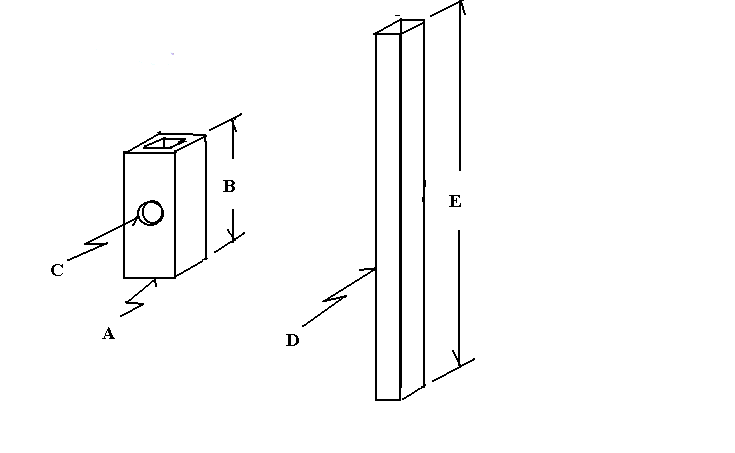 Cutting
the spacers:
Cutting
the spacers:
Figure 1
Using the drawing in Figure 1 and Figure 2,
I cut the 1 ½" tubing to the desired length of 6 ¼" and drilled the two
½" holes on opposite sides and opposite ends. I also cut the guides from 1 1/4"
square tubing to a length of 18 inches long.
Figure 2
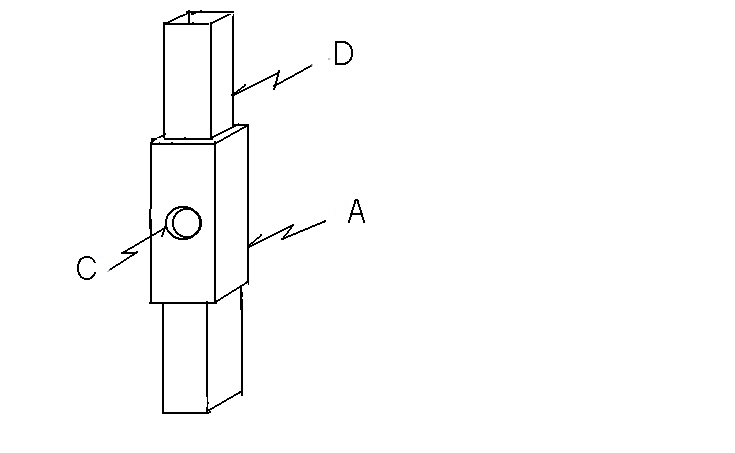
Notes:
Figures 1& 2
A = 1 1/2" sq. tubing
B = Length roof is to be raised
C = ½ Drill, drill completely through forming 2, ½" holes*
D = 1 ¼" sq. tubing
E = Length of B (height roof is to be raised) plus 12"
* When you have part A centered on part E, fill the hole C
with weld making A & E one part.
Junk Yard visit:
At this point I visited the local auto junkyard and
purchased a total of 4 automobile bumper jacks. Be sure that the jacks are the older types
– I’m not really sold on most of the newer style jacks. These can be purchased
for about five bucks each. Next step was to mark existing window supports for location of
the cuts and the location of the ½" holes that go through both sides of the tubing.
These holes will be filled with weld, making the guides a part of the over all frame when
completed. If the drilling of these holes becomes too much of a pain then a cutting torch
works mighty well. This is what I resorted to – made job a lot easier – besides,
the hole will be filled with weld.
I decided to cut them at the mid point of the existing
opening. Using a tri-square and soap stone I marked all four sides of the supports as a
guide for cutting.
Figure 4
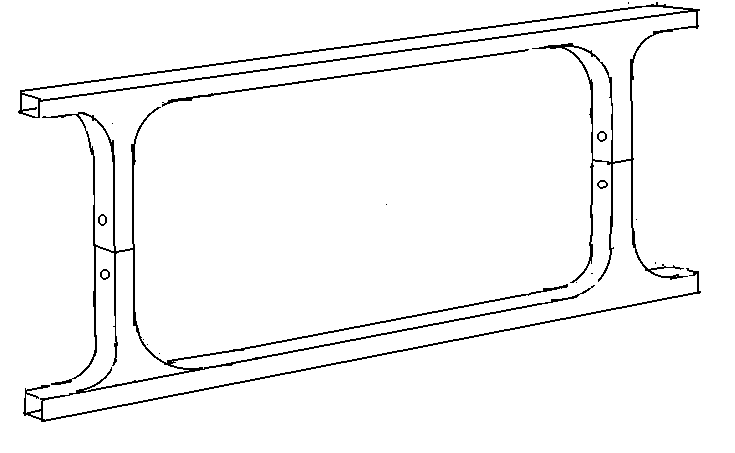 In
the front of the bus, using the horizontal frame member over the door and drivers window,
I placed one of the 2" x 12" x 14’ and used this as the place for the two
bumper jacks that are used to raise the front of the roof. Using the horizontal frame
member in the rear, where the angled window was, place another of the 2" x 12" x
14’ that will be used to support the jacks for raising the rear.
In
the front of the bus, using the horizontal frame member over the door and drivers window,
I placed one of the 2" x 12" x 14’ and used this as the place for the two
bumper jacks that are used to raise the front of the roof. Using the horizontal frame
member in the rear, where the angled window was, place another of the 2" x 12" x
14’ that will be used to support the jacks for raising the rear.
It’s cutting time:
Using a Sawsall I cut the uprights on the lines that were
laid out in Step 9. About a third back from the front cut an upright on each side, a
safety percussion, clamp or tack weld a piece of angle iron or tubing to the bottom half
of the cut upright. Be sure and make these pieces long enough to hold the roof in place
should it be a windy day. Do the same about a third from the rear. I then placed the
bumper jacks at the 4 corners and put tension on the roof. This tension may need to be
adjusted as the uprights are cut. The primary reason for the tension is to prevent the
blade from getting in a bind. I then proceeded to cut the remaining uprights.
With all the uprights cut, I then moved from jack to jack,
jacking the roof up 3 to 4 notches at a time until the roof was about 13 to 14" above
its original position. This is ample room to drop the assembled inserts into place. I then
proceeded to insert all the inserts into place and started lowering the roof back into
place.
Now with all the inserts in place the roof was raised! Raised,
in place and all aligned. Now we start the welding. I started at the front after I placed
a bar clamp on either side and pulled the top down and in place. This was to compensate
for any drawing of the metal as it is being welded. I did the same thing in the rear.
After all the uprights were welded (Figure 3) on all four sides and the holes filled with
weld it was time to grind the inside and outside surfaces smooth. If you want to grind all
welds smooth its your call. I did inside and outside only.
Figure 3
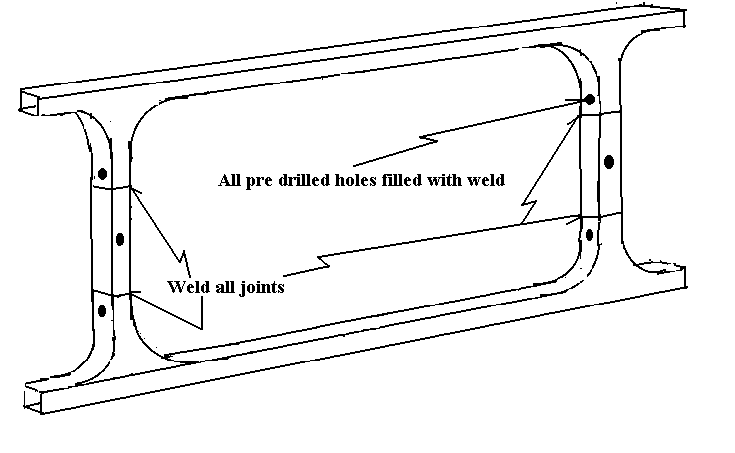
Weld in place:
With the roof successfully raised and welded in place I
decided it would be best for me to strengthen the window areas that would be covered.
Figure 4 shows the inserts I chose to use, welded into place (1 ½" square tubing).
To some this might be an over kill – to me I know its there to stay and stronger than
the original.
Figure 4
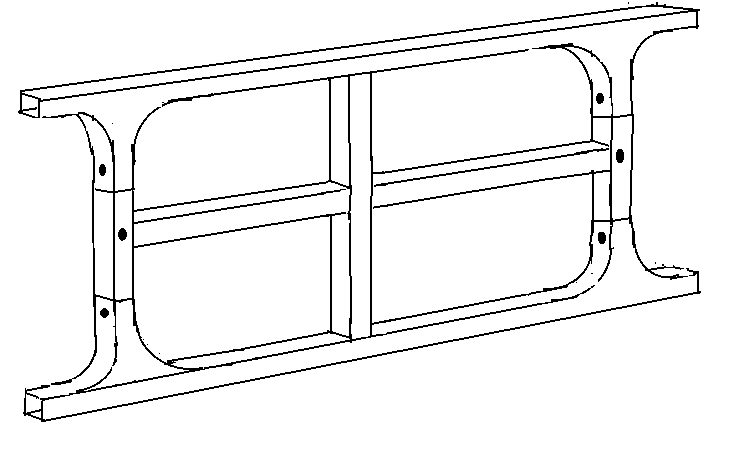
Rebuilding time:
Well, it’s rebuilding time and I started with the
front cap. After cleaning all the area the old cap occupied it is now time for a dry run.
Another set of hands was needed for this. We placed the cap in place and marked the edge
on top of the bus to be certain that the old rivet holes could be used. With this checking
out ok, we eased the cap back far enough to allow us to apply a liberal coating of cement.
I used ChemRex 943 sealer/adhesive manufactured by ChemRex
Inc (See endnote #2) it’s a terrific sealant/adhesive. When applied according to
instructions its there to stay. The only negative I have found with it is when it gets on
the skin, it’s there to stay for a good week. I have found nothing that will remove
it short of it wearing off. Should you find something that will remove it please share it.
I believe that I’ve tried everything.
With the cap in place and sealer/adhesive oozing out, from
the inside of the coach I drilled holes in the cap using the old holes as a guide. We
started in the center using an air operated rivet gun and 3/16" x ¾" rivets;
starting in the center and worked our way out to the edge of the roof.
We then moved to the front of the bus just above the
windshield again starting in the center and working our way around. Do Not, I repeat,
DO NOT rivet the area where the metal goes for covering the window area.
Installing the rear cap:
This can be lots of fun. Drill a 3/8" hole in the
center of the spot where the outside rear marker lights are to go and install a 3/8’
x 2" eye bolts that were used in removing the old cap. By fastening a chain to the
eye bolts then to a come-a-long that is attached to a vertical member of the frame
6-10’ ahead you can ratchet the cap into place. Should you want to apply several
blows with a hammer then use a rubber mallet and only in the area where you have the
eyebolts attached. The rear cap is to slide under the existing roof. Note: A silicone
lubricant can be very helpful here. Once, in place, lift the roof about 1/16" to
1/8" of an inch and apply adhesive/sealant liberally. Again, as in step 11, drill
3/16" holes using the old holes as a guide and proceed to install the rivets.
Re-skinning
At this point if you haven’t decided what skin to use,
now its time. You have at least at three choices depending on (1) personal preference, (2)
availability, (3) ease of application, (4) cost.
Choices are:
- Aluminum
- Fiberglass
- Steel
- 16 to18 gauge sheet metal
- 16 to 18 gauge paintable galvanized sheet metal
All of the suggested siding products have pros and cons
therefore the big decision is up to you. Anyone of the three will last as long as your
shell or longer.
I personally used the 16 gauge paintable galvanized sheet
metal.
Finishing touch:
All the rivets are then capped with aluminum caps supplied
by Automotive Fasteners, Inc (See endnote #3). These are easily installed and give the
appearance of having been shaved to look like round-headed rivets.
Conclusion:
There are other ways and methods to do the same thing with
good results. This simple method worked for me and I can’t take credit for this being
an original method. I have read and talked to anyone who would let me. To me this is the
result of a lot of ‘research’. In my judgement this is the simplest method to
raise the roof on an Eagle. This method will work for MCI’s, also. Maybe some of
these ideas can be useful for to you.
Enjoy your conversion experience.
End Notes:
#1 Harbor Freight 1-800-423-2567 or 800-905-5220 or on the
web www.harborfreight.com
#2 ChenRex, Inc
Industrial Division
889 Park Drive
Shakopee, MN 55379
1-800-433-9517
#3 Automotive Fasteners, Inc
2111 S. Elm - Eugene St.
Greensboro, NC 27406
1-800-632-0340
Item # MPA6 Alum Plug for 3/16 Blind Rivet
~ ~ About the Author ~ ~
Gene Lewis received a B.S. Degree in Industrial Arts from
East Carolina University, in 1963. He spent 7 years in the classroom as an Industrial Arts
Teacher and then ventured into business for himself in sales and sales management. During
the past 30 years he has continued his interest in different businesses as well as the
industrial trades.
In 1965 he built a fold up camper trailer complete with a
bed slide-out. Then in 1967 he built a 10’-6" slide in truck camper and in June
of 1968 he and his wife made an 8 week trip to Alaska. Some 4 years later he moved up to
the Motor Homes class. It was during this time he was introduced to converted buses and
was bitten with the ‘bus nut bug’. Over the years he has remained active
in designing and repairing different types of RV’s and accessories.
With the demands of a growing business and family the idea
of converting a bus had to remain only a dream. Three years ago the dream became a
reality, when out of the blue, a deal was struck for a 1968 Model 05 Silver Eagle in great
shape, complete with all the records and paper work from the day it was built in Belgium.
The decision was made to convert the bus to a custom coach done by him and for him….
his way.
Gene, with is wonderful wife Frances, have enjoyed the
world of camping and RVing since the began there wonderful trip, called marriage, some 36
years ago. He and his wife have two married children. They presently make their home in
Buies Creek, NC.
= = = = = = = = = = = = = = = = = = = = = = = = = = = = = =
= = = = = = = = = = = = = =
Questions and comments can be addressed to the author via
the web at glewis05@embarqmail.com
or by calling 910 893-8892
= = = = = = = = = = = = = = = = = = = = = = = = = = = = = =
= = = = = = = = = = = = = =
Thank you Gene for taking the time to share this with everyone - Tom